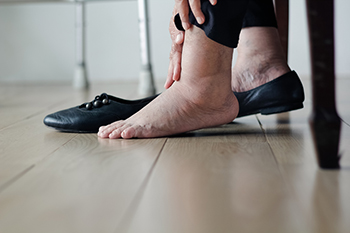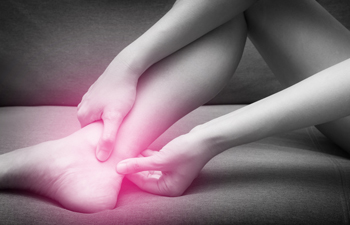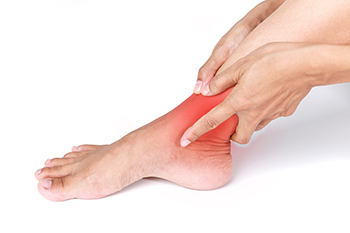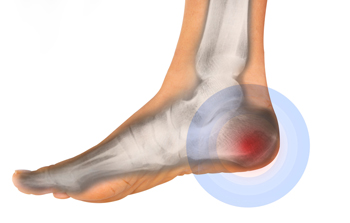August 2022

When one or more of the ligaments that hold the ankle together gets overly stretched, an ankle sprain may occur. In severe ankle sprains, the ligaments may also tear either partially or fully. Depending on the level of injury, an ankle sprain may cause pain, swelling, stiffness, and difficulty walking. The most severe type of sprain may even make it impossible to walk. Ankle sprains that do not heal properly can lead to additional sprains and possibly chronic ankle instability. This condition can cause ankle pain and weakness, and a tendency for the ankle to turn out frequently. That is why it is important to seek professional care from a chiropodist. They can diagnose your ankle sprain and create a treatment regimen appropriate for the level of severity. If you believe you have sprained your ankle, or your ankle feels weak and wobbly from a prior sprain, make an appointment with a chiropodist.
When one or more ligaments in the ankle overstretch or tear due to injury, an ankle sprain occurs. If you would like to learn more about ankle sprains, please consult with one of the chiropodists from The Footcare Centre. Our chiropodists can help you maintain the health of your lower limbs and your mobility.
Symptoms of an ankle sprain vary depending on the severity of the injury, but may include:
Pain
Swelling
Bruising
Tenderness
Difficulty walking
Ankle instability
A reduced range of motion in the ankle
Treatments for an ankle sprain may consist of:
Resting the injured ankle
Applying ice
Elevating the ankle
Compressing the ankle
Over-the-counter pain medications
Ankle braces or other devices to take weight off of the ankle
Ankle exercises
Surgery (in rare cases)
It’s important for the sprained ankle to heal correctly and fully in order to avoid repeated injury. If you have any questions, please feel free to contact our office located in . We offer the newest diagnostic and treatment technologies for all your foot care needs.

Swelling of the feet and ankles is caused by a buildup of fluid that makes the area look puffy. It generally is an indication of an unrelated malady and is usually not a problem in and of itself. Swelling may be a sign of poor circulation or a reaction to trauma. You can tell if swelling is present by pressing on the area. If it leaves an indentation on the skin, which may be shiny and tight, the area is swollen. It also can be recognized if an indentation appears on the skin when you take off your socks. Common reasons for swelling include injury, infection, inflammation, or an insect bite. In addition, some autoimmune diseases, circulatory problems, and medications may cause swelling. Sometimes, resting, icing, and elevating the foot or ankle is enough to reduce the swelling. If swelling continues, even after taking these measures, it is a good idea to visit a chiropodist for a detailed examination to identify the underlying cause. Treatment options will be determined by the source of the swelling.
Caring for your feet is not just something done at the chiropodist’s office. Good foot care starts at home. If you would like to learn more about daily foot care practices, please consult with one of the chiropodists from The Footcare Centre. Our chiropodists can help you maintain the health of your lower limbs and your mobility.
There are many things that you can do at home to help care for your feet, including:
Wearing shoes and socks that fit properly
Washing the feet daily with soap and water
Drying the feet thoroughly
Applying moisturizer to the soles and heels of the feet
Taking a walk and exercising the feet regularly
Doing foot stretches and strengthening exercises
A chiropodist can help figure out a manageable foot care routine for you to keep your feet healthy. If you have any questions, please feel free to contact our office located in . We offer the newest diagnostic and treatment technologies for all your foot care needs.

Tendonitis is when there is damage to a tendon that connects muscles to bones. It can be difficult to diagnose because it has some of the same symptoms as other ailments. When you have a problem with your Achilles tendon there will likely be pain, stiffness, swelling to nearby joints, and weakness in the surrounding muscles. You may also experience a grinding sensation when a hand is placed on the tendon because the damaged, injured cells are brought to the surface, a possible popping or snapping sound when the tendon is stretched across the bone and redness or discoloration at the site. If you are suffering several of these symptoms at the same time it is likely you have an injury to your Achilles tendon. If these progress to fever, infection is probably present and an appointment with a chiropodist is in order. A chiropodist can properly diagnose tendon or other foot and ankle issues as well as provide appropriate treatment options.
Achilles tendonitis is a common injury of the Achilles tendon, a band of fibrous tissue that runs along the back of the lower leg. The Achilles tendon can also rupture, making it impossible to lift the foot. If you are suffering from heel or calf pain, please consult with one of the chiropodists from The Footcare Centre. Our chiropodists can help you maintain the health of your lower limbs and your mobility.
Causes of Achilles tendon injuries include:
Repetitive stress or overuse
Sudden increase in activity levels
High impact injury
Calf muscle tightness or weakness
Altered foot biomechanics
Heel bone spurs
Underlying medical conditions that weaken the tendon
Symptoms of an Achilles tendon injury include:
Heel and calf pain that worsens following exercise
Chronic heel and calf pain
Sudden pain in the back of the ankle or calf
A popping or snapping sensation
Thickened lump in the Achilles tendon
Ankle and calf stiffness
Decreased range of motion in the affected foot
Swelling
Difficulty walking
Treatment
Resting the affected leg
Applying ice
Compressing the foot and ankle
Elevating the injured leg
Wearing orthotics
Low impact exercises
Stretches
Strengthening exercises
Non-steroidal anti-inflammatory medications
Cortisone injections
Surgery, if the tendon is ruptured
Achilles tendon injuries can be very painful and lead to reduced mobility if left untreated. If you have any questions, please feel free to contact our office located in . We offer the newest diagnostic and treatment technologies for all your foot care needs.

Running is an important way in which individuals across the country burn their daily calories. However, running can be taxing on your body if you are not taking care of it properly. For example, running can sometimes cause ankle pain. If you are experiencing ankle pain after a run, there are several potential reasons for the pain. You might have suffered from an ankle sprain, an ankle strain, tendinitis or a stress fracture. Regardless of the cause of your ankle pain, it is important to remember to take care of the ankle and cease activities that exacerbate the pain. You might consider taking a break from running when your ankle is causing you pain. You might also apply an ice pack to the affected area periodically, for about 10-15 minutes at a time, during the first few days of discomfort. If you are a runner and want to learn about more ways in which you can be protecting your ankles, talk to a chiropodist.
Ankle pain is a common symptom of many lower limb problems. If you are experiencing ankle pain, please consult with one of the chiropodists from The Footcare Centre. Our chiropodists will assess your condition and provide you with quality foot and ankle treatment.
The ankle is composed of a number of muscles, bones, tendons, and ligaments. There are many conditions which may cause ankle pain.
Causes
Ankle strains or sprains
Achilles tendon injuries
Fractures
Bursitis
Arthritis
Gout
Tarsal tunnel syndrome
Symptoms
If you have ankle pain, you may also experience a variety of other symptoms depending on the underlying cause of the pain. Some of these symptoms may include ankle swelling, bruising, redness, numbness or tingling, instability, and difficulty walking.
Diagnosis
The underlying cause of ankle pain can be diagnosed by a chiropodist. Diagnoses are typically made based on your medical history, a physical examination of the affected ankle, and imaging studies such as X-rays.
Treatment
Treatment for your ankle pain will depend on its underlying cause. Often, the chiropodist will recommend that you rest the affected ankle. You might also need to ice, compress, and elevate the ankle, wear an orthotic device, or take medications to reduce pain and inflammation.
If you have any questions, please feel free to contact our office located in . We offer the newest diagnostic and treatment technologies for all your foot care needs.

Many people across the country suffer from some kind of heel pain. Commonly, you might experience heel pain because of a condition known as plantar fasciitis. Although there are a multitude of different reasons why you might be experiencing heel pain, performing certain exercises might help alleviate the pain felt. One of the most common exercises is to stretch out your plantar fascia. This can be done from a seated position. Simply put one foot at a time on top of a cold water bottle and slowly roll the foot back and forth over the bottle, being careful and while gently rolling. This exercise can be performed for about one minute on one foot before alternating to the other foot. Additionally, you might try stretching your calves. This can be done by facing a wall and placing the palms of both your hands against the wall. Put one foot in front of you and another behind you. Slowly and repeatedly bend the knee of the leg in front of you as you lean forward with each bend. These are just some of the many different exercises that you might perform to alleviate heel pain. For more information, be sure to contact a chiropodist who can help.
Heel pain is a common problem that can be caused by a variety of injuries, medical conditions, and other factors. If you suffer from heel pain, please consult with one of the chiropodists from The Footcare Centre. Our chiropodists can help you maintain the health of your lower limbs and your mobility.
When it comes to heel pain, the exact location and type of pain are important to note. Some of the conditions that may cause heel pain include:
Plantar fasciitis - An inflammation of the ligament that runs along the bottom of the foot; it causes a stabbing pain under the heel that is at its worst when taking your first few steps after a long rest and while standing on your tiptoes or climbing stairs
Achilles tendonitis - An inflammation of the tendon in the back of the calf; it causes pain in the back of the heel that is at its worst after resting, as well as ankle and calf stiffness, swelling, and tenderness
Bone spurs - Bony lumps on the back of the heel bones that cause sharp pain upon first standing up; the pain becomes dull and achy over time
Heel fractures - A break or crack in the heel bone that causes pain, swelling, and difficulty walking
Retrocalcaneal bursitis - Swelling of the small, fluid-filled sac at the back of the heel bone; it causes pain, swelling, redness, and warmth in the back of the heel
Tarsal tunnel syndrome - Compression of the posterior tibial nerve which causes a pins and needles sensation in the heel, foot, and calf
Your chiropodist will be able to diagnose the underlying cause of your pain and prescribe the right treatments for you. If you have any questions, please feel free to contact our office located in . We offer the newest diagnostic and treatment technologies for all your foot care needs.
Blog Archives
- 2025
- 2024
- 2023
- 2022
- 2021
- 2020



